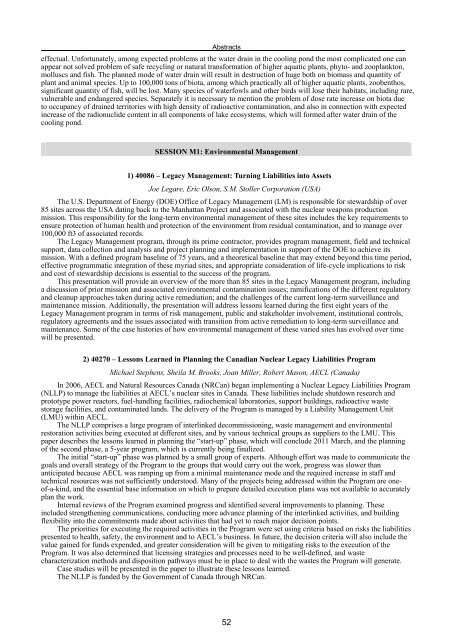The 13th International Conference on Environmental ... - Events
The 13th International Conference on Environmental ... - Events
The 13th International Conference on Environmental ... - Events
Create successful ePaper yourself
Turn your PDF publications into a flip-book with our unique Google optimized e-Paper software.
Abstracts<br />
effectual. Unfortunately, am<strong>on</strong>g expected problems at the water drain in the cooling p<strong>on</strong>d the most complicated <strong>on</strong>e can<br />
appear not solved problem of safe recycling or natural transformati<strong>on</strong> of higher aquatic plants, phyto- and zooplankt<strong>on</strong>,<br />
molluscs and fish. <str<strong>on</strong>g>The</str<strong>on</strong>g> planned mode of water drain will result in destructi<strong>on</strong> of huge both <strong>on</strong> biomass and quantity of<br />
plant and animal species. Up to 100,000 t<strong>on</strong>s of biota, am<strong>on</strong>g which practically all of higher aquatic plants, zoobenthos,<br />
significant quantity of fish, will be lost. Many species of waterfowls and other birds will lose their habitats, including rare,<br />
vulnerable and endangered species. Separately it is necessary to menti<strong>on</strong> the problem of dose rate increase <strong>on</strong> biota due<br />
to occupancy of drained territories with high density of radioactive c<strong>on</strong>taminati<strong>on</strong>, and also in c<strong>on</strong>necti<strong>on</strong> with expected<br />
increase of the radi<strong>on</strong>uclide c<strong>on</strong>tent in all comp<strong>on</strong>ents of lake ecosystems, which will formed after water drain of the<br />
cooling p<strong>on</strong>d.<br />
SESSION M1: Envir<strong>on</strong>mental Management<br />
1) 40086 – Legacy Management: Turning Liabilities into Assets<br />
Joe Legare, Eric Ols<strong>on</strong>, S.M. Stoller Corporati<strong>on</strong> (USA)<br />
<str<strong>on</strong>g>The</str<strong>on</strong>g> U.S. Department of Energy (DOE) Office of Legacy Management (LM) is resp<strong>on</strong>sible for stewardship of over<br />
85 sites across the USA dating back to the Manhattan Project and associated with the nuclear weap<strong>on</strong>s producti<strong>on</strong><br />
missi<strong>on</strong>. This resp<strong>on</strong>sibility for the l<strong>on</strong>g-term envir<strong>on</strong>mental management of these sites includes the key requirements to<br />
ensure protecti<strong>on</strong> of human health and protecti<strong>on</strong> of the envir<strong>on</strong>ment from residual c<strong>on</strong>taminati<strong>on</strong>, and to manage over<br />
100,000 ft3 of associated records.<br />
<str<strong>on</strong>g>The</str<strong>on</strong>g> Legacy Management program, through its prime c<strong>on</strong>tractor, provides program management, field and technical<br />
support, data collecti<strong>on</strong> and analysis and project planning and implementati<strong>on</strong> in support of the DOE to achieve its<br />
missi<strong>on</strong>. With a defined program baseline of 75 years, and a theoretical baseline that may extend bey<strong>on</strong>d this time period,<br />
effective programmatic integrati<strong>on</strong> of these myriad sites, and appropriate c<strong>on</strong>siderati<strong>on</strong> of life-cycle implicati<strong>on</strong>s to risk<br />
and cost of stewardship decisi<strong>on</strong>s is essential to the success of the program.<br />
This presentati<strong>on</strong> will provide an overview of the more than 85 sites in the Legacy Management program, including<br />
a discussi<strong>on</strong> of prior missi<strong>on</strong> and associated envir<strong>on</strong>mental c<strong>on</strong>taminati<strong>on</strong> issues; ramificati<strong>on</strong>s of the different regulatory<br />
and cleanup approaches taken during active remediati<strong>on</strong>; and the challenges of the current l<strong>on</strong>g-term surveillance and<br />
maintenance missi<strong>on</strong>. Additi<strong>on</strong>ally, the presentati<strong>on</strong> will address less<strong>on</strong>s learned during the first eight years of the<br />
Legacy Management program in terms of risk management, public and stakeholder involvement, instituti<strong>on</strong>al c<strong>on</strong>trols,<br />
regulatory agreements and the issues associated with transiti<strong>on</strong> from active remediati<strong>on</strong> to l<strong>on</strong>g-term surveillance and<br />
maintenance. Some of the case histories of how envir<strong>on</strong>mental management of these varied sites has evolved over time<br />
will be presented.<br />
2) 40270 – Less<strong>on</strong>s Learned in Planning the Canadian Nuclear Legacy Liabilities Program<br />
Michael Stephens, Sheila M. Brooks, Joan Miller, Robert Mas<strong>on</strong>, AECL (Canada)<br />
In 2006, AECL and Natural Resources Canada (NRCan) began implementing a Nuclear Legacy Liabilities Program<br />
(NLLP) to manage the liabilities at AECL’s nuclear sites in Canada. <str<strong>on</strong>g>The</str<strong>on</strong>g>se liabilities include shutdown research and<br />
prototype power reactors, fuel-handling facilities, radiochemical laboratories, support buildings, radioactive waste<br />
storage facilities, and c<strong>on</strong>taminated lands. <str<strong>on</strong>g>The</str<strong>on</strong>g> delivery of the Program is managed by a Liability Management Unit<br />
(LMU) within AECL.<br />
<str<strong>on</strong>g>The</str<strong>on</strong>g> NLLP comprises a large program of interlinked decommissi<strong>on</strong>ing, waste management and envir<strong>on</strong>mental<br />
restorati<strong>on</strong> activities being executed at different sites, and by various technical groups as suppliers to the LMU. This<br />
paper describes the less<strong>on</strong>s learned in planning the “start-up” phase, which will c<strong>on</strong>clude 2011 March, and the planning<br />
of the sec<strong>on</strong>d phase, a 5-year program, which is currently being finalized.<br />
<str<strong>on</strong>g>The</str<strong>on</strong>g> initial “start-up” phase was planned by a small group of experts. Although effort was made to communicate the<br />
goals and overall strategy of the Program to the groups that would carry out the work, progress was slower than<br />
anticipated because AECL was ramping up from a minimal maintenance mode and the required increase in staff and<br />
technical resources was not sufficiently understood. Many of the projects being addressed within the Program are <strong>on</strong>eof-a-kind,<br />
and the essential base informati<strong>on</strong> <strong>on</strong> which to prepare detailed executi<strong>on</strong> plans was not available to accurately<br />
plan the work.<br />
Internal reviews of the Program examined progress and identified several improvements to planning. <str<strong>on</strong>g>The</str<strong>on</strong>g>se<br />
included strengthening communicati<strong>on</strong>s, c<strong>on</strong>ducting more advance planning of the interlinked activities, and building<br />
flexibility into the commitments made about activities that had yet to reach major decisi<strong>on</strong> points.<br />
<str<strong>on</strong>g>The</str<strong>on</strong>g> priorities for executing the required activities in the Program were set using criteria based <strong>on</strong> risks the liabilities<br />
presented to health, safety, the envir<strong>on</strong>ment and to AECL’s business. In future, the decisi<strong>on</strong> criteria will also include the<br />
value gained for funds expended, and greater c<strong>on</strong>siderati<strong>on</strong> will be given to mitigating risks to the executi<strong>on</strong> of the<br />
Program. It was also determined that licensing strategies and processes need to be well-defined, and waste<br />
characterizati<strong>on</strong> methods and dispositi<strong>on</strong> pathways must be in place to deal with the wastes the Program will generate.<br />
Case studies will be presented in the paper to illustrate these less<strong>on</strong>s learned.<br />
<str<strong>on</strong>g>The</str<strong>on</strong>g> NLLP is funded by the Government of Canada through NRCan.<br />
52
















